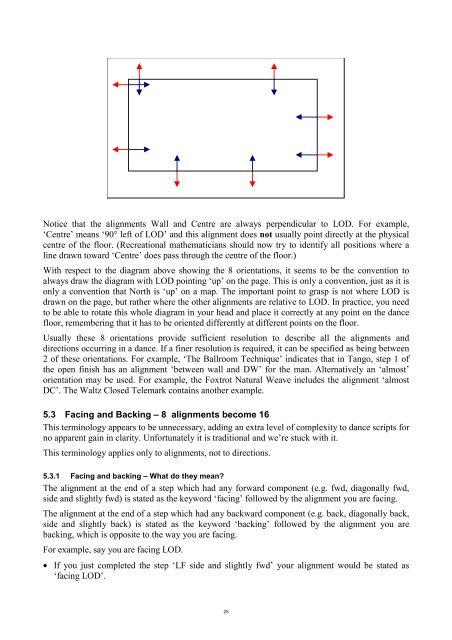Reading Ballroom Dance Scripts - Dance - Plussed.net
Reading Ballroom Dance Scripts - Dance - Plussed.net
Reading Ballroom Dance Scripts - Dance - Plussed.net
Create successful ePaper yourself
Turn your PDF publications into a flip-book with our unique Google optimized e-Paper software.
Notice that the alignments Wall and Centre are always perpendicular to LOD. For example,<br />
‘Centre’ means ‘90° left of LOD’ and this alignment does not usually point directly at the physical<br />
centre of the floor. (Recreational mathematicians should now try to identify all positions where a<br />
line drawn toward ‘Centre’ does pass through the centre of the floor.)<br />
With respect to the diagram above showing the 8 orientations, it seems to be the convention to<br />
always draw the diagram with LOD pointing ‘up’ on the page. This is only a convention, just as it is<br />
only a convention that North is ‘up’ on a map. The important point to grasp is not where LOD is<br />
drawn on the page, but rather where the other alignments are relative to LOD. In practice, you need<br />
to be able to rotate this whole diagram in your head and place it correctly at any point on the dance<br />
floor, remembering that it has to be oriented differently at different points on the floor.<br />
Usually these 8 orientations provide sufficient resolution to describe all the alignments and<br />
directions occurring in a dance. If a finer resolution is required, it can be specified as being between<br />
2 of these orientations. For example, ‘The <strong>Ballroom</strong> Technique’ indicates that in Tango, step 1 of<br />
the open finish has an alignment ‘between wall and DW’ for the man. Alternatively an ‘almost’<br />
orientation may be used. For example, the Foxtrot Natural Weave includes the alignment ‘almost<br />
DC’. The Waltz Closed Telemark contains another example.<br />
5.3 Facing and Backing – 8 alignments become 16<br />
This terminology appears to be unnecessary, adding an extra level of complexity to dance scripts for<br />
no apparent gain in clarity. Unfortunately it is traditional and we’re stuck with it.<br />
This terminology applies only to alignments, not to directions.<br />
5.3.1 Facing and backing – What do they mean?<br />
The alignment at the end of a step which had any forward component (e.g. fwd, diagonally fwd,<br />
side and slightly fwd) is stated as the keyword ‘facing’ followed by the alignment you are facing.<br />
The alignment at the end of a step which had any backward component (e.g. back, diagonally back,<br />
side and slightly back) is stated as the keyword ‘backing’ followed by the alignment you are<br />
backing, which is opposite to the way you are facing.<br />
For example, say you are facing LOD.<br />
• If you just completed the step ‘LF side and slightly fwd’ your alignment would be stated as<br />
‘facing LOD’.<br />
25


